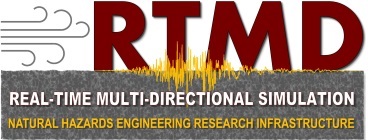Development of a Real-Time Multi-Site Hybrid Testing Tool for NEES
Project Overview
The goal of this NEESR-SD project is to develop, examine, implement, and demonstrate robust and accurate synchronization control tools that provide the capability to conduct real-time, multi-site experiment and simulation tests within the NEES framework. The ability to conduct real-time, multi-site experiments and simulation tests will allow NEES to reach its full potential as a distributed network of diverse equipment sites. Geographically-distributed, real-time testing between multiple NEES equipment sites will engage not just the diverse NEES experimental facilities, all with unique experimental and simulation capabilities, but in doing so will also bring together stakeholders with diverse backgrounds throughout earthquake engineering community. This innovative test technique will allow for larger and more complex experiments to be realized and provide experimental information from dynamic loading conditions previously not available. The project will develop simulation control algorithms necessary to implement real-time, multi-site experiments and examine the sensitivities of these algorithms to network delays, as well as measurement noise and variability and uncertainty in model parameters. A series of tests are planned using a small-scale system to develop and examine concepts and validate these methods with a fully physical shake table test. A user interface tool, based on the NEES Real-time Data Viewer (RDV), will be developed to facilitate conducting multi-site hybrid tests. Large-scale, real-time, multi-site experiments on full-scale NEES equipment will be conducted to demonstrate the application of these methods within the NEES network. An Internet-based education and outreach tool that accesses actual test data from the small-scale and large-scale tests will be developed to demonstrate the tools and methodologies developed within this research to the greater community. A training workshop will be held at the Lehigh NEES facility at the end of the project to promote the distributed use of NEES facilities through hybrid testing within both the NEES and the structural control communities. The results will be disseminated through NEES cyberinfrastructure, including NEEScentral, NEESforge and RDV.


